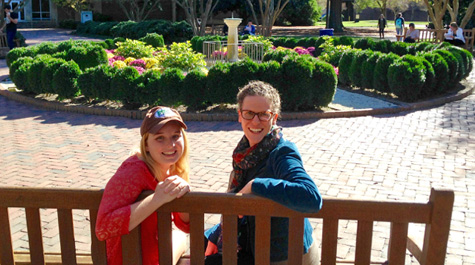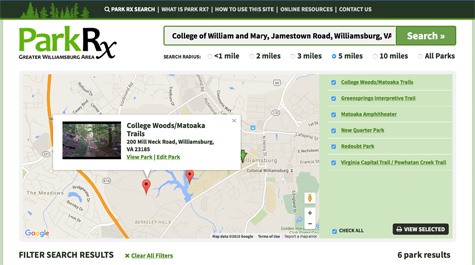Thinking outside the pill box: a prescription for parks
With busy schedules filled with classes, homework, jobs and club meetings, every student has his or her favorite outdoor spot at William & Mary to relax, unwind and regroup. For Katie McElheny '17, the patio behind the School of Education provides the ideal location.
"In the late afternoons, it's a great place to go to get away from hustle of main campus and just decompress," said McElheny.
A project at William & Mary is hoping to help others find such places on campus and in the Williamsburg community as part of their healthcare treatment plans. Established this past summer in Dorothy Ibes’ Parks Research Lab, the Greater Williamsburg Area Park Prescriptions Program (GWA Park Rx) provides local healthcare providers with the tools and training to prescribe their patients time in local parks to promote physical and mental health. The Williamsburg project is part of an international Parks Rx movement and was funded with a grant from the Committee on Sustainability, with additional support from the Environmental Science & Policy program, Charles Center and Center for Geospatial Analysis.
"We have visited and thoroughly surveyed over 40 parks within a 20-mile radius of the College for possible activities, amenities, environment, trails and accessibility,” said Ibes, a lecturer in the Environmental Science & Policy Program and the Center for Geospatial Analysis. “Every aspect of this project, from the search tool design to the park variables surveyed, is rooted in decades of scientific research on the relationship between parks and health, and proven methods for promoting healthy behaviors.”
Park Rx is designed to facilitate what the Parks Lab coins the “Mental Health Trifecta” –greenspace, physical activity, plus socialization – to amplify the benefits of getting outside, said Ibes.
“Spending even five to 10 minutes in an outdoor greenspace – for example the sundial, Sunken Garden or terrace – has been shown to reduce depression, anxiety and attention disorders while enhancing concentration, mood and overall well-being,” said Ibes. “My hope is that the Park Rx program, either directly or indirectly, will encourage patients and the broader community to spend just a little more time outdoors and less time in front of screens.”
Having first heard of the program in July 2014 after coming across an article about the D.C. Park Rx Program headed by Dr. Robert Zarr at Unity Healthcare, Ibes began developing a pilot program at William & Mary with the assistance of the Environmental Science & Policy Program, the Charles Center, the Committee on Sustainability, students and Zarr himself.
“Dr. Zarr and the web designer of D.C. Park Rx, Matt Scribner, were instrumental in the development of the program here in the Greater Williamsburg area,” said Ibes.
Since its establishment, 14 William & Mary undergraduate students have joined the lab to work on the Parks Rx program including most recently: McElheny, Robert Boyd ‘16, Hannah Cannon ‘18, Katie Johanson '15, Hannah Kwawu '18, Tyler Treakle ’18 and Catie Liebeck ‘16. The students are responsible for substantial developments in the GWA Park Rx program this past year and a half, said Ibes.
As summer researchers, the students worked on a variety of projects from visiting and surveying parks to creating promotional materials, managing the PRL database and compiling scholarly research.
“I’m very excited about the experience I gained working in the Parks Research Lab, especially because it relates so closely to my area of study,” said McElheny a public health major. “In working on the literature review, I learned a lot about the benefits of public green space use and how our community can get the most out of the parks we have. I'm hoping to go into health promotion and prevention in the future, so it was really amazing to be able to participate first hand in a community level health initiative.”
Along with gathering data, students also aided in training healthcare providers from Sentara as well as the Student Health Center and Counseling Center on campus. Those who undergo training by PRL researchers are known as Park Ambassadors, all of whom and are listed on the GWA Parks Rx website. These individuals are trained not only on how to utilize the PRL online search tool and greenspace map, but also on how prescribing parks can aid in treating and preventing common ailments such as depression, obesity and attention disorders.
“I think that this is important work, especially on campus with the growing need for mental health treatment options,” said Cannon. “In such a technological age, it is important to stress that time outside, especially for recreation, is so important to our well-being.”

















